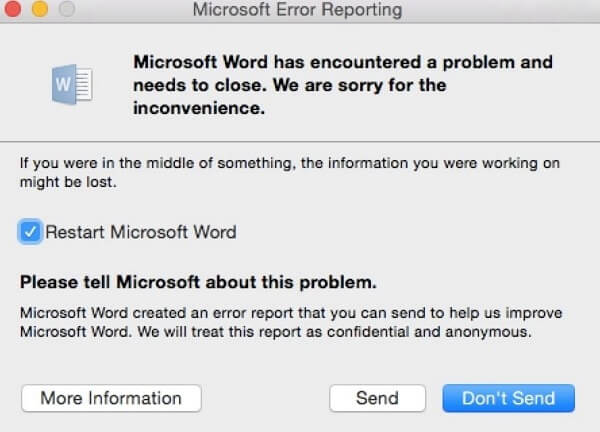

- On mac for word why does it say ~$ for mac#
- On mac for word why does it say ~$ update#
- On mac for word why does it say ~$ full#
On mac for word why does it say ~$ for mac#
Got more Office for Mac tips you think might be helpful to other knowledge workers? Please share them with me using one of the social media links below. Collaborating on a document or report? Learn to use ^a to navigate through any comments entered into it.You know you’ve entered a digit wrong, but you’re wrangling a huge document? Type ^? to scroll quickly through every number you’ve entered in your document.

If you use too many extra line spaces type ^p^p in the Find field and ^p in the Replace field to find and edit the errors.I’m less convinced Microsoft Office for Mac users have come across these three Find-and-Replace tips: I’m certain most readers know they can use Find and Replace to apply edits in a document, such as replacing a consistently misspelled word. Own an iPhone, but working on a Mac and you need to input data provided on a printed sheet? You don’t need to conduct this task manually anymore - just use the Data from Picture tool to photograph the data using your iPhone, use OCR to convert it and automatically place it in the relevant part of your Excel spreadsheet. With the text selected, open Edit>Clear>Clear Formatting.Tap the handy but eternally forgotten Remove Formatting tool – look for the letter A with a tiny pink eraser icon masking the right-hand foot of the A.To get rid of that formatting and return to nice crisp text, just select the copy and either: You take text from another document or website and find that you’ve imported formatting you just don’t need. Or click thrice to select the text in an entire paragraph.Click twice to select the entire word you just clicked.Click once to enter the cursor in a section of text.I suspect more people don’t know about or use this than those who do when selecting text: It's so much faster than writing your words and then amending their placement. The cursor magically appears where you need it to be and you can begin writing in that alignment (left, right, center).Double-click the blank area in your document in which you want your text to go – left, right or center of the page.Want to pop something into your document that’s aligned differently than the rest of it? Perhaps you’re writing a letter and want to center a line of text in an otherwise left aligned document? This tip lets you place the text in your chosen alignment immediately, so you don’t need to select it and assign alignment subsequent to writing. It takes me directly to my most recently edited word in a document, or the section I was working on when I last saved a document once I’ve opened it again.
On mac for word why does it say ~$ full#
A full disk is just one of many possible causes, so the message is quite misleading.I use Shift-F5 a lot. It's triggered by Word not obtaining an acknowledgement that the write to disk was completed successfully. The reason there's no single, magic fix is that "Unable to Save: Disk Full or Too Many Files Are Open" is a stupid choice of language for what is in fact a generic "unable to save" message. This applies only to new documents existing documents will be saved in whatever format they are already in. You can specify the default format for saving documents under Word -> Preferences -> Save. You may need to copy-paste some of the original graphics into the new version. docx one, as the conversion (epecially of graphic elements) is often imperfect. doc version until you've closely reviewed the. The solution, for me, has been to open the "save as" menu and save in the. It affects only certain documents, and the only common feature that I can identify is that (a) they have a lot of graphics in them, and (b) they're stored in the old. I've been having the same problem running Word 2008, earlier under Leopard and Snow Leopard, and now, still, under Mountain Lion. Other than that I will also be saving a backup copy (under preferences > save).
On mac for word why does it say ~$ update#
The documents should be identical and you can now save the new document (B) with another name.įrom what I've read this is a MS issue (as always) and you should update your software regularly.Go back to A, select all (command+A) and copy (command+C).Go to track changes and make sure it is OFF but make sure "Final Showing Markup" is selected along with all the markup options. Open a new document (B) and view in print preview mode.To be on the safe side I selected all markups. Under the Review pane make sure "Final Showing Markup" is selected. Keep your exisiting document (A) open.This is extremely frustrating as an editor but I've found a quick way to save your current changes: I went to my other mac to see if the changes from the last hour were updated and they were not. I was tracking changes while editing for about an hour until I got the dreaded "hard disk full" message. I just recently ran into this issue while tracking changes in Word for Mac 2011 on my iMac running 10.6.8.


 0 kommentar(er)
0 kommentar(er)
